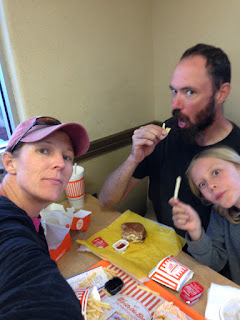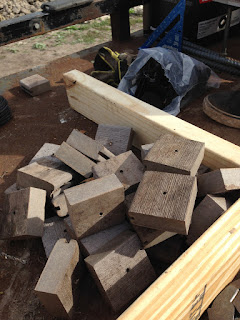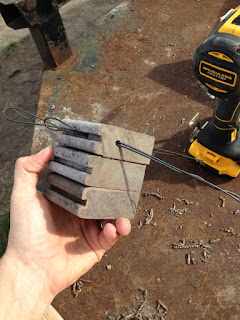From start to finish, in cold and hot weather, with gentle breezes and gale force winds, with and without help from friends, the final footing was poured yesterday. Who-hoo, ten footings!
Can you believe on this monumental moment only one single picture was taken! ONE! Oh sure, there was a camera running to capture the whole process but only one still image. No close ups, no steps of the process, no moment in time. And, to make matters worse, the only picture was of me attempting to run the skill saw. Really!
Yesterday was the second time I have tried to run the saw. The first time was on footing #1 and it was a disastrous experience. Board was cut wonky and eyes were watery. To make matters worse, the board being cut didn't have to be cut straight. If the 2x4 were cut on an angle it didn't affect the final results. They were just formboards. Later, I tried again on the plastic boards used to create the chairs for the re-bar mats. If the chairs were not exactly square it would not affect the structure and integrity of the footing and would not be seen by anyone once concrete was poured on top. So why did I freak out? Because, because, because.....I have issues, okay. "Hello, my name is OCD". It just HAS to be perfect. I can tell the Kid "practice makes perfect" but then I expect to run the saw perfectly the first time. Or even by the second time. Practice what you preach. Oh, OCD, why? Why???
Not including prep time, but from the moment the mixer was turned ON to when it was turned OFF, a footing could be poured in a little over an hour. Not bad for amateurs. At what point are you no longer amateurs? Does having poured 10 footing make you practiced? Of course, we are not skilled or professional by any means, but can be at least be past beginner? Novice. Is that the next level of skills?
In order to complete a pour this quickly meant the Planner and the Kid had to have all materials ready and waiting for my arrival. And let me tell you, with winter daylight hours, it was a mad dash from the office at 4 pm to pour a footing and clean up before dark. There were a few days when headlamps were being used.
The sheer amount of materials used to pour footings was amazing. It was not more than the Planner calculated but it was too close for comfort for my taste. When sand and rocks are being raked together to fill in the last buckets, it just TOO close. Why add that layer of stress? Just by an extra 100lbs or so. Jesh.
Steps for pouring concrete never changed. Not even tweaked. Even with the Sailor helping, the process still took the same amount of time. Having his help allowed duties to rotate. This meant I didn't have to tamp and fill buckets of rock, the Planner didn't have to fill cement and pour all materials into the mixer, and yes, it allowed the Kid a break from shoveling sand and getting water on hot days.
Yes, having friends help allowed the Kid to play a little more. The kid was a trooper, though. He hung in with his duties without squawking until footing #8. Then all deals were off.
But hey, he got to put his mark on the deal on footing #8. Look how big his foot is. Didn't think it was gonna fit on the footing. By the end of clean up of footing #8, he was done.
By footing #9, there was the need for constant reminders and the promise of rewards to finish out the footing. Rewards had to be of high value. Promises of an extra desert... only those of little will power would agree to that. The Kid, he went for the big guns. "Yes please, I will drive the tractor all by my onesies." What were we to say, no? Please, we are not that mean. Just sometimes. By the end footing #9, he was nowhere to be found. His sand would be shoveled (sometimes) and poof he was gone, vanished, nowhere to be seen or heard.
From footing #1 on Jan 14 to footing #10 on Jan 30, there were cloud cover cool days (perfect),
followed by extremely hot days (wear your sombreros and long sleeve, thin cotton shirts, shorts and boots, and sunscreen. Lots and lots of ice cold water refills were needed on those days!),
to down right, cold blistery days (and no, not just cold for me either. Just cold. Yes, in case you are wondering at the picture, I have on four layers of clothing: tank top, t-shirt, and two thermals.) This winter has held true to form. "Welcome to Texas ya'll, today it's 85 and sunny, tomorrow it will be 45 and cloudy."
After ten footings worth of tamping, and tamping, and more freaking tamping, my body was showing some signs of usage. When working, I would have thought my hands would be the first thing to cramp up with the constant rubbing of the re-bar against my palms. But it wasn't. It was in my back and arms. Muscles were tight in places I didn't know there were muscles. Just look what tamping did to the end of the re-bar. Once rusty and rough with texture is now shiny and smooth. That's friction baby!
All in all, it was a fine experience. Am I ready to pour footings for the house tomorrow? Hell no! I might not even be ready in a month. Will I be willing to pour footings for the house eventually? Yes. Just make it two or three months down the road. No, wait, that won't work because it will be the middle of the summer. So make it eight or nine months down the road and I will be ready to pour footings again. Sure, no problem.
Oh, wait I just remembered, there were two pictures taken on the last day of pouring footings. The second picture had nothing to do with the footing process. But, haha, it has everything to do with a celebratory dinner. And where else would we celebrate? Whataburger!!!! It was the Kid's idea. Honestly. Ask him. On a side note, I live with clowns. They are available for usage anytime and they come cheep.














































































